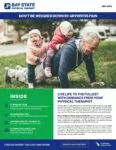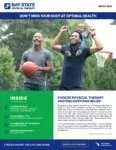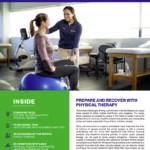Be honest, do you ignore back pain to get through the day? At first, it might work. You drive to work but feel a bit achy sitting in the car. You lift your kids but experience sharp pain when doing so. Still, you continue to ignore it. Pretty soon you’re skipping your tennis match with friends because swinging a racquet is too painful. Then, before you know it, you’re taking a sick day to simply lie down. It’s a slippery slope and avoiding the root cause of your pain can prolong the agony and slow your return to your normal level of activity.
Where Your Back Pain Comes From
Low back pain may describe what you feel, but it is not a specific disease or diagnosis. Instead, it is simply a symptom of what you may be feeling. The origin of your back pain can come from one or more of the structures of your musculoskeletal system. Those structures include:
- Muscles
- Tendons
- Ligaments
- Intervertebral discs
- Nerves
- Vertebrae
Pain in your low back is very common. In fact, according to the American Association of Neurological Surgeons, 75-80% of Americans will experience back pain at some point during their lifetime. Of those people, 50% will have multiple back pain episodes within a year!
Common Back Pain Diagnoses Physical Therapy Can Help
Back injuries are common but often ignored or misunderstood. Below you’ll find information about four of the most common back conditions we see in physical therapy.
Sciatica
Sciatica is the term used to describe radiating pain into the buttock that can travel down the back of the thigh. Often this pain is achy and spread out along these areas. Sciatica is a result of irritation to the sciatic nerve, which travels deep in the buttock and down the back of the leg. In about 20% of people, the sciatic nerve pierces through the piriformis muscle deep in the buttock instead of under it. This can make the sciatic nerve more susceptible to irritation and pressure from the piriformis muscle. The piriformis muscle helps guide hip movement but can become very tight with prolonged sitting. This increased tightness causes pressure and irritation to the sciatic nerve causing pain.
Spinal Stenosis
Spinal stenosis refers to a narrowing of the central spinal canal or the canals where the nerves exit the spine to the lower legs (called foramen). These canals are made up of overlapping spinal bones (vertebrae) over another. With degeneration of the spinal joints, collapsing of the disc height, or abnormal bone growth, the canals can narrow. This leads to rubbing and even pressure on the nerves, which can cause a multitude of symptoms.
Degenerative Disc Disease
Degenerative diseases of the spine fall under the categories of Degenerative Disc Disease (DDD) or Degenerative Joint Disease (DJD). In the spine, this is typically due to age and genetics. The wearing down of the joints or discs causes a loss in the normal height of the bony segments in the back. This can cause excessive joint pressures, bone-on-bone rubbing, and increased inflammation. Typically with DDD or DJD comes stiffening of the spinal joints and weakening of key spinal muscles.
Herniated Disc
The bones of the spine, the vertebrae, are cushioned by fluid-filled discs. A herniated disc, also called a bulging or slipped disc, refers to an area of the disc that has been pushed out of its normal place. Your discs change as you age, drying out and becoming more brittle. In addition, as the discs dry out with age, the change in height between the vertebrae decreases, causing changes in posture and function. In younger adults, the center of the disc (nucleus) is held in place by many rings of the disc (picture a cross-section of a tree trunk).
Choose Physical Therapy to Overcome Back Pain
Your physical therapist will perform a thorough evaluation, review your medical history, and work with your physician to properly treat your specific back pain diagnosis or whatever medical condition has brought you to physical therapy. As a part of your personalized treatment program, your physical therapists will use treatments such as dry needling, therapeutic massage, cupping, exercise, and many other services that can help you reduce pain and regain function to return to the activities you love most.
Don’t ignore your back pain! With our network of clinics across Massachusetts and Rhode Island, you can find a Bay State Physical Therapy clinic near you by visiting our website!
To learn more, call your nearest Bay State Physical Therapy location or complete the form below to request an appointment.
Resources:
- https://www.healthline.com/health/back-pain
- https://www.aans.org/en/Patients/Neurosurgical-Conditions-and-Treatments/Herniated-Disc
- https://www.jospt.org/doi/full/10.2519/jospt.2021.0304
Tags: Therapeutic Massage, disc disease, Low back pain, cupping, Herniated Disc, Sciatica, dry needling, stenosis






